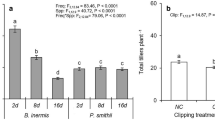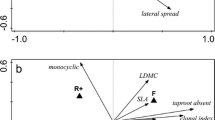Abstract
We measured rhizome branching, clonal mobility, and ramet longevity of 98 meadow plant species. A cluster analysis applied to this dataset revealed nine clonal growth types that differ mainly by the ramet lifespan and vegetative mobility. Then we compared the abundance of these groups of clonal species between the three following plant communities: (1) open, (2) restored and (3) overgrown wooded meadows in the Laelatu-Nehatu-Puhtu Nature Reserve, Estonia. This is the first study where the quantitative values of belowground clonal traits have been measured for all species of a species-rich community. We show that species with annual ramets and with a low vegetative mobility were most abundant in open grasslands. The relative abundance of perennial species with annual ramets was positively correlated with shoot density and species diversity, indicating that high ramet turnover rates combined with a high genet longevity can positively affect species coexistence in meadow communities. Hence, this study provides evidence for the fact that the average values of clonal life-history parameters differ between these communities. Herb communities under forest canopy consist, in average, of species with ramets that live longer and are clonally more mobile than in the communities of open sites.
Similar content being viewed by others
References
Altesor, A., Pezzani, F., Grun, S. and Rodriguez, C. (1999) Relationship between spatial strategies and morphological attributes in a Uruguayan grassland: a functional approach. J. Veg. Sci. 10, 457-462.
Anderson, M.C. (1964) Studies on the woodland light climate. I. The photographic computation of light conditions. J. Ecol. 52, 27-41.
Bazzaz, F.A. (1998) Plants in Changing Environments: Linking Physiological, Population, and Community Ecology. Cambridge University Press, Cambridge.
Bell, A.D. (1984) Dynamic morphology: a contribution to plant population ecology. In R. Dirzo and J. Sarukhán (eds) Perspectives on Plant Population Biology. Sinauer Assoc., Sunderland, MA, pp. 48-65.
Callaghan, T.V., Headley, A.D., Svensson, B.M., Lixian, L., Lee, J.A. and Lindley, D.K. (1986) Modular growth and function in the vascular cryptogam Lycopodium annotinum. Proc. R. Soc. Lond. B. 228, 195-206.
Eckert, C.G. (1999) Clonal plant research: proliferation, integration, but not much evolution. Am. J. Bot. 86, 1649-1654.
Eriksson, O. (1997) Clonal life histories and the evolution of seed recruitment. In The Ecology and Evolution of Clonal Plants. Backhuys Publishers, Leiden, H. de Kroon and J. van Groenendael (eds) pp. 211-226.
Groenendael, J.M., van Klimeš, L., Klimešova, J. and Hendriks, R.J.J. (1996) Comparative ecology of clonal plants. Phil. Trans. R. Soc. Lond. B. 351, 1331-1339.
Grubb, P.J. (1990) Demographic studies on the perennials of chalk grasslands. In S.H. Hillier, D.W.H. Walton and D.A. Wells (eds) Calcareous Grasslands: Ecology and Management. Bluntisham Books, Bluntisham, pp. 93-97.
Grubb, P.J., Kelly, D. and Mitchley, J. (1982) The control of relative abundance in communities of herbaccous plants. In E.I. Newman (ed.) The Plant Community as a Working Mechanism. British Ecological Society, Cambridge, pp. 79-97.
Harper, L. (1977) Population Biology of Plants. Academic Press, London.
Harper, L. (1985) Modules, branches, and the capture of resources. In J.B.C. Jackson, L.W. Buss and R.E. Cook (eds), Population Biology and Evolution of Clonal Organisms. Yale University Press, New Haven, pp. 1-33.
Herben, T., Krahulec, F., Hadincová, V. and Kovárová, M. (1994) Small-scale spatial dynamics of plant species in a grassland community over six years. J. Veg. Sci. 4, 171-178.
Herben, T., Krahulec, F., Hadincová, V. and Pechácková, S. (1997) Is a grassland community composed of coexisting species with low and high spatial mobility? Folia Geobot. Phytotax. 29, 459-468.
Huber, H. and Stuefer, J.F. (1997) Shade-induced changes in the branching pattern of a stoloniferous herb: functional response or allometric effect? Oecologia 110, 478-486.
Hutchings, M.J. and de Kroon, H. (1994) Foraging in plants: the role of morphological plasticity in resource acquisition. Adv. Ecol. Res. 25, 159-238.
Jonsdottir, I.S. and Watson, M.A. (1997) Extensive physiological integration: an adaptive trait in resource-poor environments? In H. de Kroon and J. van Groenendael (eds) The Ecology and Evolution of Clonal Plants. Backhuys Publishers, Leiden, pp. 109-136.
Kalamees, R. (1999) Seed Bank, Seed Rain and Community Regeneration in Estonian Calcareous Grasslands. PhD Thesis. Tartu University Press, Tartu.
Kalamees, R. and Zobel, M. (1998) Soil seed bank composition in different successional stages of a species rich wooded meadow in Laelatu, western Estonia. Acta Oecol. 19, 175-180.
Kivenheimo, V.J. (1947) Untersuchungen über die Wurzelsysteme der Samenpflanzen in der Bodenvegetation der Wälder Finnlands. Ann. Bot. Soc. Zool. Bot. Fenn. Vanamo 22(2), 1-180.
Klimeš, L. (1992) The clone architecture of Rumex alpinus (Polygonaceae). Oikos 63, 402-409.
Klimeš, L. (1999) Small-scale plant mobility in a species-rich grassland. J. Veg. Sci. 10, 209-281.
Klimeš, L., Klimešova, J., Hendriks, R. and van Groenendael, J. (1997) Clonal plant architecture: a comparative analyses of form and function. In H. de Kroon and J. van Groenendael (eds) The Ecology and Evolution of Clonal plants. Backhuys Publishers, Leiden, pp. 1-29.
Krall, H. and Pork, K. (1970) Laclatu puisniit. In E. Kumari (ed.) Lääne-Eesti rannikualade loodus. Valgus, Tallinn, pp. 115-128.
Kukk, T. and Kull, K. (1997) Puisniidud [Wooded Meadows]. Estonia Maritima 2, 1-249.
Kull, K. (1995a) Growth form parameters of clonal herbs. In K. Aaviksoo, K. Kull, J. Paal and H. Trass (eds) Consortium Masingii. Tartu University, Tartu, pp. 106-115.
Kull, T. (1995b) Genet and ramet dynamics of Cypripedium calceolus in different habitats. Abstr. Bot. 19, 95-104.
Kull, K., Sammul, M. and Tamm, A. (2000) Comparative Ecomorphology of Clonal Growth: A Little Atlas. Manuscript Institute of Zoology and Botany, Tartu.
Lepš, J. (1999) Nutrient status, disturbance and competition: an experimental test of relationships in a wet meadow. J. Veg. Sci. 10, 219-230.
Lovett Doust, L. (1981) Population dynamics and local specialization in a clonal perennial (Ranunculus repens). 1. The dynamics of ramets in contrasting habitats. J. Ecol. 69, 743-755.
Maarel, E. van der (1996) Pattern and process in the plant community: fifty years after A.S. Watt. J. Veg. Sci. 7, 19-28.
Maarel, E. van der and Sykes, M.T. (1993) Small-scale plant species turnover: the carousel model and a new niche concept. J. Veg. Sci. 4, 179-188.
Maarel, E. van der and Sykes, M.T. (1997) Rates of small-scale species mobility in alvar limestone grassland. J. Veg. Sci. 8, 199-208.
Mitchley, J. and Grubb, P.J. (1986) Control of relative abundance of perennials in chalk grassland in Southern England. 1. Constancy of rank order and results of pot-and field-experiments on the role of interference. J. Ecol. 74, 1139-1166.
Pärtel, M. and Zobel, M. (1995) Small-scale dynamics and species richness in successional alvar plant communities. Ecography 18, 83-90.
Pärtel, M., Kalamees, R., Zobel, M. and Rosén, E. (1998) Restoration of species-rich limestone grassland communities from overgrown land: the importance of propagule availability. Ecol Engin. 10, 275-286.
Pärtel, M., Zobel, M., Zobel, K. and Maarel, E. van der (1996) The species pool and its relation to species richness: evidence from Estonian plant communities. Oikos 75, 111-117.
Pokarzhevskaya, G.A. (1995) Morphological analysis of alpine communities of the north-western Caucasus. Folia Geobot. Phytotax. 30, 197-210.
Rysin, L.P. and Rysina, G.P. (1987) Morfostruktura Podzemnyh Organov Lesnyh Travjanistyh Rastenii. Nauka, Moskva.
Skálová, H., Pecháčková, S., Suzuki, J.I., Herben, T., Hara, T., Hadincová, V. and Krahulec, F. (1997) Within population genetic differentiation in traits affecting clonal growth: Festuca rubra in a mountain grassland. J. Evol. Biol. 10, 383-406.
Sykes, M.T., Maarel, E. van der, Peet, R.K. and Willems, J.H. (1994) High species mobility in species-rich plant communities: an intercontinental comparison. Folia Geobot. Phytotax. 29, 439-448.
Tamm, C.O. (1948) Observations on reproduction and survival of some perennial herbs. Botaniska Notiser 3, 305-321.
Weiher, E., Werf, A. van der, Thompson, K., Roderick, M., Garnier, E. and Eriksson, O. (1999) Challenging Theophrastus: a common core list of plant traits for functional ecology. J. Veg. Sci. 10, 609-620.
Author information
Authors and Affiliations
Rights and permissions
About this article
Cite this article
Tamm, A., Kull, K. & Sammul, M. Classifying clonal growth forms based on vegetative mobility and ramet longevity: a whole community analysis. Evolutionary Ecology 15, 383–401 (2001). https://doi.org/10.1023/A:1016093116926
Issue Date:
DOI: https://doi.org/10.1023/A:1016093116926




